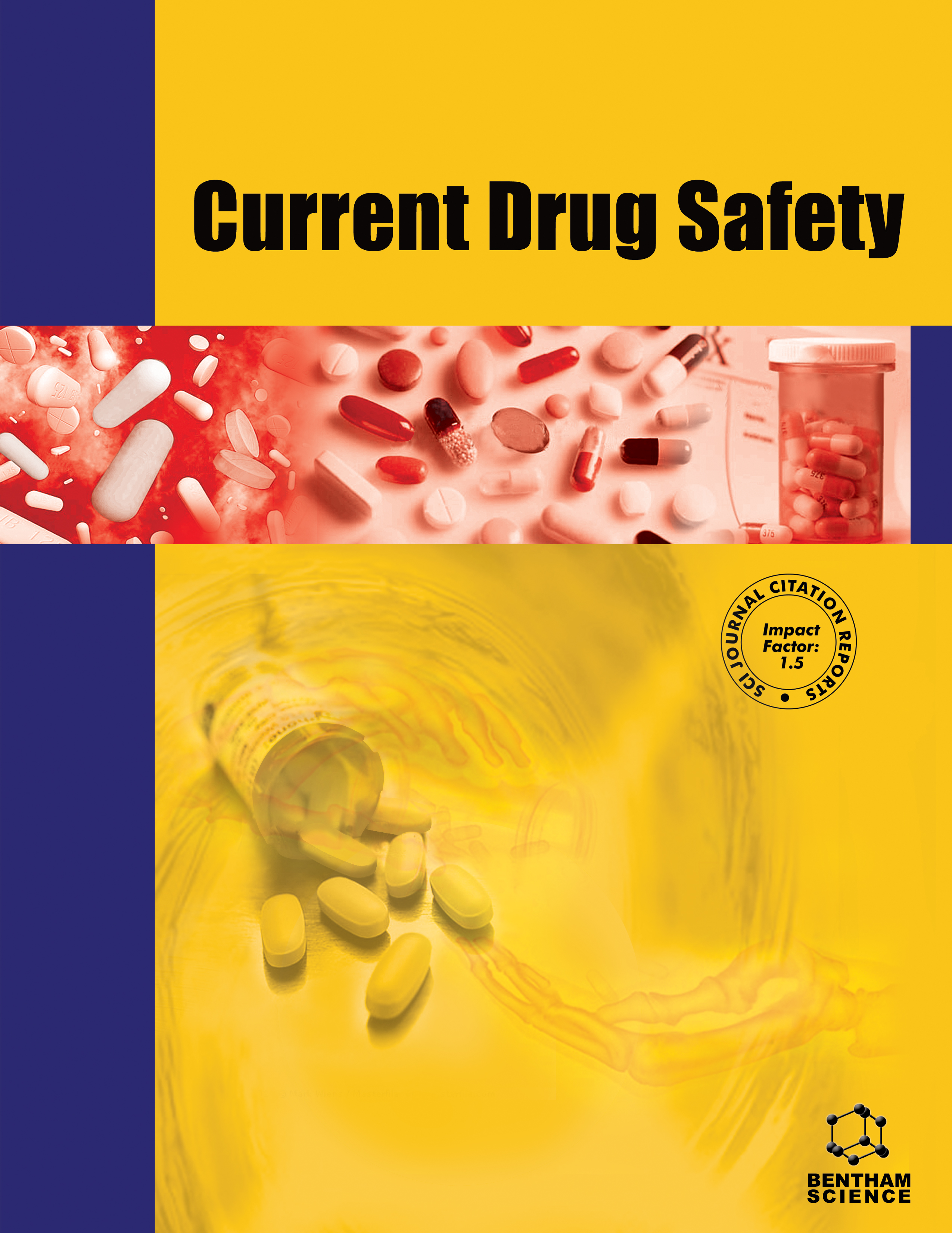- Home
- A-Z Publications
- Current Drug Safety
- Previous Issues
- Volume 17, Issue 2, 2022
Current Drug Safety - Volume 17, Issue 2, 2022
Volume 17, Issue 2, 2022
-
-
COVID-19: Are Experimental Drugs a Cure or Cause?
More LessAuthors: Bensu Karahalil and Aylin ElkamaBackground: Coronavirus disease 2019 (COVID-19) is a new strain of coronavirus. It is characterized by severe acute respiratory syndrome coronavirus 2 (SARS-CoV-2). It has quickly influenced all over the world since it spreads easily. Common symptoms are fever, cough, difficulty in breathing and muscle aches. Despite the urgent need to find an effective antiviral treatment, already available agents are being used al Read More
-
-
-
Assessment of COVID-19 Treatment Advised in Different Ethnic Populations
More LessAuthors: B. Arjun, P.R. Krishnendu, Leena K. Pappachen and Subin M. ZachariahA virus is an infectious agent that can only replicate within a host organism and can infect a variety of living organisms, including bacteria, plants, and animals. Viruses are so small that a microscope is necessary to visualize them, and they have a very simple structure. A coronavirus is a group of viruses that can cause diseases, for instance, the basic cold, severe acute respiratory syndrome (SARS), and the Middle East respirato Read More
-
-
-
Drug-Induced QTc Prolongation: What We Know and Where We Are Going
More LessAuthors: Erinn Mangona, Elisa Sandonato, Todd N. Brothers and Jayne PawasauskasDrug-induced QTc prolongation is a concerning electrocardiogram (ECG) abnormality. This cardiac disturbance carries a 10% risk of sudden cardiac death due to the malignant arrhythmia, Torsades de Pointes. The Arizona Center for Education and Research on Therapeutics (AzCERT) has classified QTc prolonging therapeutic classes, such as antiarrhythmics, antipsychotics, anti-infectives, and others. AzCERT criteria catego Read More
-
-
-
Investigating Potential Drug-Drug Interactions from Greek e-Prescription Data
More LessBackground: The prevalence of potential drug-drug interactions (pDDIs) is indicative of the prevalence of actual drug-drug interactions and prescription quality. However, they are significantly understudied in Greece. Objective: The objective of the study was to determine the prevalence of pDDIs among outpatients and identify factors associated with their occurrence. Methods: Anonymous e-prescription data between 20 Read More
-
-
-
Potentially Inappropriate Medication Use in Older People: A Crosssectional Study Using Beers Criteria
More LessAuthors: Gülsüm H. Yüksel, Fuat Nihat Ozaydin and Ayse Nilufer OzaydinBackground: The use of Potentially Inappropriate Medications (PIMs) is common and negatively affects elderly health and disease prognosis. Objective: This study aims to analyze the frequency of PIMs in the elderly health records registered to a family health center and to identify risk factors, prescription/nonprescription distribution, distribution by healthcare institutions, number of doctors visits, and health literacy. Met Read More
-
-
-
Quality Assessment of Pre-Clinical Studies of Chimeric Antigen Receptor T-Cell Therapy Products: A Point of Focus on Safety
More LessAuthors: Vikas Maharshi, Diksha Diksha and Pooja GuptaBackground: Serious adverse reactions have been reported with the use of Chimeric Antigen Receptor (CAR) T-cell therapy in a clinical setting despite the success of these products in pre- clinical stages of development. Objective: We evaluated the quality of available pre-clinical safety data of CAR T-cell therapy products. Methods: A 21 items safety checklist was designed specifically for CAR T-cell. Literature was searched usi Read More
-
-
-
Adverse Drug Reaction Profile of Anticancer Agents in a Tertiary Care Hospital: An Observational Study
More LessAuthors: Sana P. Shaikh and Rajan NerurkarBackground: Anti-cancer agents are known to be toxic, leading to a number of adverse drug reactions (ADRs). ADRs not only increase the financial burden on the patient/healthcare system but also decrease the quality of life. Understanding the burden of ADR will help strengthen the knowledge on patient safety and implement intervention strategies to reduce it. Objectives: The objectives of the study are as follows: 1. To study th Read More
-
-
-
Hydroxychloroquine and Azithromycin Combination in the Management of COVID-19 Infection: Safety and Effectiveness Challenges
More LessAuthors: Ahmed E. Abou Warda, Mahmoud Tammam, Rabab A. El-Gazar, Rania M. Sarhan and Sayed GaberBackground: The treatment of COVID-19 disease remains a dilemma so far because there is no approved therapy for it. This study aimed to evaluate the use of hydroxychloroquine and azithromycin combination in treatment. Objectives: This study was carried out to determine the safety and effectiveness of hydroxychloroquine and azithromycin combination in COVID 19 patients. Methods: This study included 90 adult COV Read More
-
-
-
Acute Kidney Injury Related to Intravenous Colistin Use in Lebanese Hospitalized Patients: Incidence and Associated Factors
More LessAuthors: Malak Khalifeh, Abdalla El-Lakany and Lama SoubraBackground: Colistin use has increased because of the emergence of infections caused by resistant gram-negative bacteria. Acute kidney injury (AKI) remains a treatment-limiting factor for widespread colistin clinical use. This study aimed at determining the incidence and the factors associated with the development of colistin-induced AKI. Methods: A retrospective observational study was conducted by reviewing files Read More
-
-
-
A Meta-Analysis of Safety of Different Regimens of Remdesivir in COVID-19 Patients
More LessAuthors: Mahanjit Konwar, Miteshkumar Maurya and Debdipta BoseRemdesivir is an adenosine analogue drug that targets RNA-dependent RNA polymerase enzyme and inhibits viral replication. As of 22nd October, 2020, US FDA fully approved the drug Remdesivir for the treatment of COVID-19 patients who requires hospitalisation. Many clinical studies reported the derangement in hepatic and renal function tests, which is alarming considering the health conditions of the COVID-19 patie Read More
-
Volumes & issues
-
Volume 20 (2025)
-
Volume 19 (2024)
-
Volume 18 (2023)
-
Volume 17 (2022)
-
Volume 16 (2021)
-
Volume 15 (2020)
-
Volume 14 (2019)
-
Volume 13 (2018)
-
Volume 12 (2017)
-
Volume 11 (2016)
-
Volume 10 (2015)
-
Volume 9 (2014)
-
Volume 8 (2013)
-
Volume 7 (2012)
-
Volume 6 (2011)
-
Volume 5 (2010)
-
Volume 4 (2009)
-
Volume 3 (2008)
-
Volume 2 (2007)
-
Volume 1 (2006)
Most Read This Month
Article
content/journals/cds
Journal
10
5
false
en


